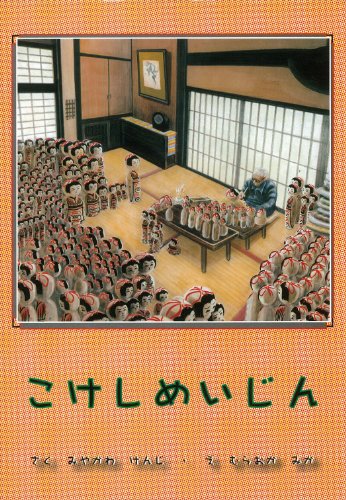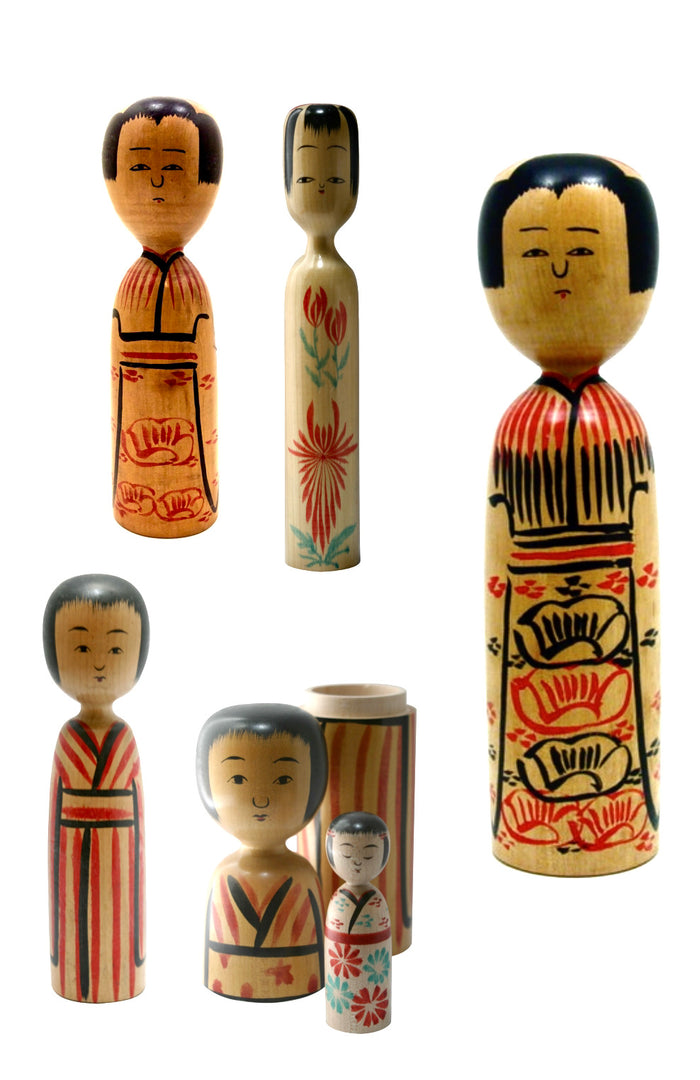


Vintage Japanese Traditional Kijiyama Kokeshi entitled: “Maedare” by Kyutaro, Ogura (1906-1998)
Dimensions: 12-3/4” h
This specific doll was featured in a book in Japanese entitled: The Master of Kokeshi: Ogura Kyutaro, he was a Grand Kiji-ya Master who created this style of Kijiyama Kokeshi, and who passed away at the age of 91. This book is “out of print”, and was published in English, Spanish, and Portuguese. We were fortunate to receive a copy of the Japanese version at its introduction in 2001. Mingeiarts has sold several Kijiyama dolls including a smaller version of this doll, and has held this extra-large doll in our holdings since it was purchased in the early 70’s at a presentation given by this artist.
The doll is unique in its overall design and motif and became the most representative doll of the Kijiyama strain known by the name Maedare, (meaning apron in Japanese). The doll's head, which has been described as an “inverted egg”, sits on top of the shoulders, with a red bow, above, for decoration. The expressive face and exaggerated hairstyle, with bold bangs, set wide apart framing the face, give this Kokeshi a more realistic appearance, which became the standard for this style of doll. Her striped bodice, with stacked and stylized Chrysanthemums on her apron, was conceived in the early 1950s. The doll is painted in black outline with red accents, celebrating the natural characteristics of the dogwood, (Hanamizuki). It was formed from one piece of wood, (the standard wood used for this doll was maple, and atypically cherry, and dogwood). The doll has a rich chestnut hue, which adds a warm and inviting aesthetic to the doll. It is finished in a natural-colored candle wax, (Rosoku no ro), to seal the wood and protect it from daily wear. There is beautiful script writing on the back, with the doll’s identification and the artist’s signature, which was standard placement for this inscription. This doll was fully made by Kyutaro-san, who studied under Hisashiro, Ogura. Later versions were made by family members who would lathe-turn the dolls and Ogura-san would complete the artwork on the body.
See additional writings on our website related to this subject: Under our Browse and Learn section, please refer to: https://mingeiarts.com/collections/kijiyama-kei-family.
Condition: Pristine meaning that the piece retains its original craft/workmanship showing a wonderful- developed patina commensurate with its age. It is void of damage, cracks, breakage, or repairs, and meets all the standards of the collectible Traditional Kijiyame-kei Family dolls.

Japanese Traditional Kokeshi
Kijiyama-Kei (Family)
Prefecture: Akita
Origin:
One of the most readily recognizable traditional dolls is the Kijiyama type, from the region of the same name in the Akita Prefecture. The name is derived from the wood craftsmen (Kiji-ya), who live in the remote mountains of the Tohoku region. The actual location of Kijiyama is so remote that it was inaccessible in the harsh winter months. Many of the kokeshi makers left and settled in the less remote areas of Kawazura, now part of Inagawa-machi. Some suggest that the dignified, lonely look on the faces of Kiiyama kokeshi reflects the lonesome past of their birthplace.
Collector's note – characteristics / painting style:
Despite the slightly sad look some of these kokeshi have, they are very appealing and sought after for their well-defined style. Their elongated “inverted egg” shaped head is attached to a relatively chunky body, both of which are well proportioned. They typically have a red hair ribbon-like motif, but some can be without any hair ribbon (Okappa style), with a “bobbed” hairstyle and half or full moon bangs across the forehead. The eyes can be shut or partially closed (tsubushi-me), or fully opened, and may or may not have eyebrows. Their nose shapes are typically rounded, with small single or double-line lips. The most common motif on the body incorporates chrysanthemums, which were common in the earlier versions. Plum blossoms are seen on those dolls, which are closely associated with the Ogura family. The body usually possesses a kimono-like painted design in several distinctive patterns, suggesting an apron (maedare), over the kimono, which was incorporated later in the doll's development. Additionally, a striped overall patterned kimono-clad is seen as an alternative to the apron. Some have what is called a Kasuri pattern using a kanji symbol. Most Kijiyama dolls demonstrate the same state of being within this style of Kokeshi.

Leading Craftsmen:
Abe, Heishiro, 1929-2013, (Inagawa, Akita) - Master: Takahashi, Heijiro. No additional published information
Abe, Yoko, 1932, (Yuzaya, Akita) - Master: Abe, Heishiro. No additional published information
Honma, Isao, 1935. The third son of Shimazo and Rio Honma is a schoolteacher in Tsubakigawa, Higashinaruse Village, Ogachi District, and Akita Prefecture. His family owned forestland, so he loved woodworking from elementary school, making wooden carvings including Kokeshi, bears, and furniture. No additional published information.
Igawa, Takemitsu, 1925-2008, (Inagawa Akita) - Master: Ozeki, Kyutaro. No additional published information.
Kitayama, Kenichi - No additional published information
Koyasu, Ichigoro - No additional published information
Onodera, Masanori, 1948-2018. Kijiyama lineage, Master: Tokuichi Onodera. The eldest son of Onodera Tokuichi in Odate, Kawatsuraya, Akita Prefecture. The Onodera family had been lacquer artists in Kawatsuraya for generations. It is said that Fujimi (childhood name Umetaro), who was a lacquer artist, innovated the painting and decorating Kokeshi dolls and started the painting method of apron. After graduating from the Yuzawa Kita branch school, Masanori worked as a lacquer artist for two years and then studied woodworking for one year. He learned lathe working from his father Tokuichi. No additional published information.
Ogura, Kyutaro, 1906-1998, Grand Master (Minase, Akita) - Master: Ogura, Kyushiro. No additional published information
Ogura, Tomezo, 1909, (Inagawa, Akita) - Master Ogura, Kyushiro. No additional published information
Onodera, Juichi, 1908, (Inagawa, Akita) - Master Ogura, Keitaro. No additional published information
Sato, Hideichi, 1927, (Inagawa, Akta), Master Sato, Kaneichi. No additional published information
Shibata, Ryoji, 1944, (Inagawa, Akita)) - Master Shibata, Tetsuzo. The second son of Keijiro Ogura and Mura in Yafumae, Odate, Kawatsurē Village, Akita Prefecture, and in 1958, at the age of 15, he made a Kijiyama doll which influenced his lifetime profession throughout his life. No additional published information is available.
Suzuki, Koutaro, 1922-1989, (Inagawa, Akita) - Master Takahashi, Heijiro. No other published information.
Takahashi, Yuji, 1934 - No additional published information.
Explore & Learn More about Kijiyama-Kei (Family)